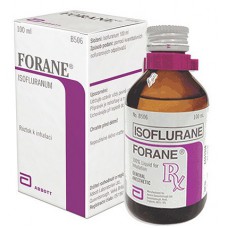Expiration date: 05/2026
Active substance
isoflurane(isoflurane)
Pharmacological group
Drug for inhalation anesthesia
Product form, composition and packaging
Liquid for inhalation anesthesia transparent, colorless, volatile, with a characteristic smell.
100 ml-dark glass bottles (6) - plastic boxes.
250 ml-dark glass bottles (6) - plastic boxes.
Clinical and pharmacological group
Drug for inhalation anesthesia
Registration ##
liquid d / ingal. anesthesia 100%: FL. 100 or 250 ml-P ?012733/01, 29.12.06
ATC code
N01AB06
The description of the drug FORAN is based on the officially approved instructions for the use of the drug FORAN for specialists and approved by the manufacturer for publication in 2008
Pharmacological action
Drug for inhalation anesthesia. It causes a rapid onset of General anesthesia and a quick exit from it. A slight irritant effect of isoflurane can limit the rate of introduction into General anesthesia. The drug does not cause excessive secretion of salivary and tracheobronchial glands. Pharyngeal and laryngeal reflexes are quickly suppressed.
The level of General anesthesia in the application of isoflurane can change rapidly. With an increase in the depth of General anesthesia, spontaneous breathing is suppressed, so it should be carefully monitored and, if necessary, maintained.
At the stage of introduction to General anesthesia, there is a decrease in blood PRESSURE, which quickly normalizes in the surgical stage of anesthesia, the heart rate does not change.
With supportive anesthesia, blood PRESSURE decreases in proportion to the depth of anesthesia, but the heart rate remains stable. During the ventilator with normal pCO2 minute volume of the heart remains constant, regardless of the depth of General anesthesia, and is maintained mainly by increasing the heart rate. With spontaneous breathing, developing hypercapnia can lead to an increase in the heart rate and minute volume of the heart, which exceed those in awakening.
With superficial anesthesia, cerebral blood flow does not change, but tends to increase with deep anesthesia, which can lead to a transient increase in the pressure of cerebrospinal fluid (CSF). Increased pressure of the CSF can be prevented or reduced by hyperventilation before or during anesthesia.
Changes in EEG and convulsive activity are extremely rare when using isoflurane. In General, isoflurane causes changes in EEG, comparable with those in the application of other drugs for inhalation anesthesia.
Isoflurane significantly less increases the sensitivity of the myocardium to the action of adrenaline than enfluran. There is limited evidence that subcutaneous infiltration of up to 50 ml of epinephrine 1:200000 does not cause the development of ventricular arrhythmias in patients during General anesthesia with isoflurane.
With normal levels of General anesthesia muscle relaxation may be adequate for some intra-abdominal operations. If more pronounced muscle relaxation is required, it is possible to/in the introduction of small doses of muscle relaxants.The depth of anesthesia is easily controlled.
Isoflurane can be used to administer General anesthesia and maintain General anesthesia.
Pharmacokinetics
Suction
Cmax inorganic fluorine in serum is usually less than 5 µmol / l and is determined 4 h after anesthesia. The fluorine level returns to normal within 24 hours.
Metabolism and excretion
In the body, only a small amount of isoflurane is metabolized. Known metabolites of isoflurane did not possess toxicity or have determined in too low concentrations.
In the postoperative period, only 0.17% of the dose of isoflurane can be detected as metabolites in urine.
Indications for use of the drug
- induction and maintenance of General anesthesia.
The drug can be used for sedation for 48 hours in patients who undergo ventilation in the intensive care unit.
Dosage regimen
For precise control over the feed concentration of isoflurane should be used specially calibrated vaporizers.
Levels of MAC isoflurane in oxygen depend on age.
The values of MAC (minimum alveolar concentration) of isoflurane depending on the age
1 FL. (100 ml)
isoflurane 100 %
Drugs used for premedication should be selected individually, keeping in mind that isoflurane can cause depression of the respiratory center. You can choose to use anticholinergics.
Short-acting barbiturates or other drugs used for induction anesthesia are usually used with subsequent inhalation of isoflurane. As an alternative, isoflurane with oxygen or with oxygen-oxide mixture can be used.
When inhaled into General anesthesia with isoflurane, it is recommended to use 0.5% concentration at the beginning. Concentrations from 1.5% to 3.0% usually cause a surgical level of General anesthesia after 7-10 min.
Maintaining the surgical level of anesthesia can be provided 1-2.5% isoflurane in oxygen-oxide mixture. When using isoflurane in pure oxygen, its concentration should be increased by 0.5-1%. If necessary, additional use of muscle relaxants is possible.
To provide anesthesia for cesarean section, it is sufficient to use 0.5-0.75% isoflurane in an oxygen-oxide mixture.
During maintenance of General anesthesia blood PRESSURE level in the absence of other factors is inversely proportional to the level of alveolar concentration of isoflurane. With the deepening of anesthesia should reduce the concentration of isoflurane in the inhaled mixture to prevent excessive reduction of blood PRESSURE.
Lower concentrations of isoflurane are required to maintain surgical levels of General anesthesia in elderly patients.
Sedation can be maintained 0.1-1% isoflurane in the oxygen-oxide mixture, the appropriate dose is selected individually.
Side effect
Adverse reactions, which were recorded in the application of Foran usually depend on the dose and reflect the pharmacological activity of the drug.
From the side of respiratory system: respiratory depression is possible.
Of the cardiovascular system: possible cardiac arrhythmias, hypotension.
From the laboratory parameters: transient increase in the number of blood leukocytes, even in the absence of surgical stress.
From the digestive system: in some cases - liver damage (from a small and transient increase in the activity of liver enzymes to necrosis of hepatocytes).
In the postoperative period: chills, nausea, vomiting, and bowel obstruction.
Contraindications to the use of the drug
- malignant hyperthermia in history,
- hypersensitivity to isoflurane.
With caution, Foran should be used in intracranial hypertension.
Pregnancy and lactation
The safety of Foran use in pregnancy is not established.
Blood loss in abortion in cases of Foran is comparable to blood loss in the application of other means for inhalation anesthesia.
Evidence of the effectiveness and safety of using Foran for General anaesthesia in obstetrics are lacking, with the exception of application for caesarean section.
Isoflurane in concentrations up to 0.75% demonstrated safety for effective maintenance of anesthesia for cesarean section. No adverse reactions to the use of isoflurane in cesarean section were observed.
There is no information about excretion of isoflurane with breast milk. In the period of breastfeeding, Foran should be used with caution.
Special instruction
The drug significantly increases cerebral blood flow especially in deep anesthesia. There may be a transient increase in the pressure of the cerebrospinal fluid, which returns from the original with hyperventilation. When using ioflupane postoperative cerebral complications were found relatively rarely.
When Foran is administered, the level of General anesthesia can change quickly and easily, so it is recommended to use only carefully calibrated evaporators or to conduct monitoring to assess the inhaled and exhaled concentration. With an increase in the depth of General anesthesia, there is an increase in arterial hypotension and suppression of respiratory function. The degree of hypotension and respiratory depression may be an indication of the depth of General anesthesia.
Clinical experience with Foran even with prolonged exposure does not provide information about hepatotoxicity. However, the lack of extensive experience of repeated use of the drug does not allow to identify the symptoms of effects on liver function.
Like other halogen-containing drugs Foran should be used with caution in patients with high intracranial pressure. In these cases, controlled hyperventilation may be necessary.
In patients receiving Foran observed transient change bromsulfaleinovy test, increased levels of glucose and serum creatinine and the reduction of the residual urea nitrogen, serum cholesterol and alkaline phosphatase.
In susceptible individuals, inhalation anaesthetics, including isoflurane, can cause hypermetabolism of skeletal muscles, which leads to an increase in their oxygen demand and the development of a clinical syndrome known as malignant hyperthermia . The first sign of this syndrome is hypercapnia, and its clinical symptoms may include muscle rigidity, tachycardia, tachypnea, cyanosis, arrhythmias and/or instability of blood PRESSURE. Some of these nonspecific symptoms may also appear in mild anesthesia, acute hypoxia, hypercapnia, and hypovolemia.
Treatment of malignant hyperthermia involves the abolition of drugs that caused its development,/in the introduction of dantrolene and supportive symptomatic therapy. Later, renal insufficiency may develop, so diuresis should be monitored and, if possible, maintained.
The use of drugs for inhalation anesthesia in children caused in rare cases an increase in serum potassium, which led to the development of cardiac arrhythmias and death in the postoperative period. This condition in particular can develop in patients with latent or clearly occurring neurological diseases, especially in patients with Duchenne myodystrophy. In some cases, there was a link with the simultaneous use of succinylcholine. In these patients, there was also a significant increase in serum CPK, a change in the composition of urine and myoglobinuria. Unlike malignant hyperthermia and some similarities in the manifestation of such patients have never been muscle rigidity or symptoms associated with hypermetabolism of muscles. With the threat of development of such States, osobennosti in identifying the patient's latent current of neuromuscular disease, should be started immediately measures for the relief of hyperkalemia and resistant arrhythmias.
There are reports of some cases increasing the levels of carboxyhemoglobin when using halogen-containing anesthetic agents containing a group - CF2H, such as desflurane, isoflurane and enfluran. In the presence of normally hydrated sorbents CO2 rises concentration of nitrous oxide of carbon is not observed.
Replacement of dried CO2 sorbents
When using isoflurane with over-dried CO2 sorbents (especially containing potassium hydroxide), rare cases of excessive overheating and/or spontaneous ignition in anesthesia machines are described.
If the anesthesiologist suspects that the CO2 sorbent is dry, it should be replaced before using Foran. When the CO2 sorbent dries, the color of the indicator does not always change. Therefore, the absence of changes in the color of the indicator can not be considered a confirmation of adequate hydration. CO2 sorbents should be changed regularly, regardless of the color of the indicator.
Use in Pediatrics
Efloran can be used in infants and children under 2 years are acceptable to all other commonly used drugs for anesthesia degree of risks and benefits.
Overdose
In case of overdose, discontinue administration of Foran, maintain airway patency, start auxiliary or controlled ventilation with oxygen and maintain adequate cardiovascular function.
Drug interaction
Isoflurane significantly potentiates the action of all known muscle relaxants, and to a greater extent non-depolarizing muscle relaxants.
Neostigmin eliminates the action of non-depolarizing muscle relaxants, but does not affect the muscle relaxation caused by isoflurane itself.
All muscle relaxants are compatible with isoflurane.
With simultaneous use of isoflurane with nitrogen oxide (N2O), MAC reduction was observed in adult patients.
Terms and conditions of storage
List B. the Drug should be stored out of reach of children, at a temperature not exceeding 30°C. shelf life – 5 years.


